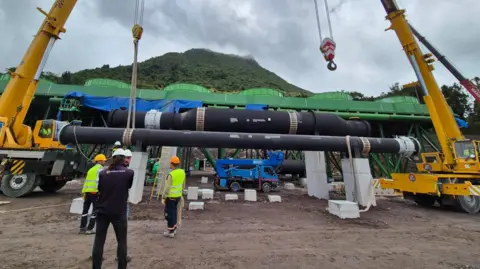Dominica, an island nation characterized by its lush rainforests, scenic waterfalls, and active volcanoes, is on the cusp of a significant transformation in its energy landscape, which could redefine its environmental impact and the sustainability of its energy sources. Known as the “Nature Island,” Dominica has gained popularity over the years among ecotourists, recording a notable increase in visitors—83,966 in the previous year, marking a 13% rise from 2023, largely due to new direct flight routes from the United States and the introduction of additional hotel facilities. After recovering from the devastation of Hurricane Maria in 2017, the island government is keen to leverage its exceptional natural resources to provide a cleaner electricity source for its approximately 66,000 residents and the burgeoning tourism sector.
With an aim to eliminate dependence on diesel-fueled electricity generation, Dominica is embarking on an ambitious project: the construction of a geothermal power station located in the south of the island near the village of Laudat, nestled within the verdant Roseau Valley. This facility will tap into the earth’s natural underground reservoirs, exploiting hot water heated by volcanic rocks to produce electricity. The planned 10-megawatt power plant is expected to become operational by the end of the year, employing steam to drive turbines and subsequently cooling and reinjecting the used steam back underground for continuous operation.
Dominica’s Energy Minister, Dr. Vince Henderson, has expressed aspirations of completely removing the need for diesel electricity generation by 2030. The geothermal plant is expected to lower electricity costs while fitting seamlessly into a broader strategy for renewable energy usage. Interestingly, the development is not exclusive to Dominica; future plans include the potential export of surplus electricity through underwater cables to neighboring islands, promoting regional energy interconnectivity.
The geothermal facility will mark Dominica’s entry as the second country in the Caribbean to develop such capabilities, following Guadeloupe, which has operated a geothermal plant for three decades. The project is being carried out as a public-private partnership between the Dominican government and the US-Israeli energy powerhouse, Ormat Technologies, with tens of millions of dollars in costs supported by grants and loans from several governments and organizations, including the U.S., U.K., Japan, and the World Bank.
Despite the promising prospect of renewable energy, the project has not been without its challenges and concerns. Local residents, including environmentalists like Atherton Martin, are voicing worries about ecological preservation in the Roseau Valley, which is distinctive for its biodiversity. There have been reports of wildlife disturbance due to the removal of vegetation for exploration purposes. Furthermore, some community members have raised questions regarding the cost implications of the project, which has reportedly seen the Dominican government investing around $15 million.
Dr. Henderson acknowledges the difficulties faced by Dominica in improving its power infrastructure post-Hurricane Maria, asserting that the geothermal initiative, while complex, is a worthwhile investment in the island’s future. One common concern surrounding geothermal facilities is the potential for induced seismic activity; however, Ormat’s management assures that throughout their extensive operational history, such incidents have not occurred.
The development of this geothermal plant is expected to set a precedent for similar projects across the Caribbean islands. Doron Blachar, Ormat’s CEO, remarked on the reliability of geothermal energy, emphasizing its zero-emissions profile and ability to generate power continuously, independent of fluctuating weather conditions. With an objective to harness geothermal resources well beyond Dominica, Ormat is also expanding capacities in Guadeloupe and collaborating on projects in other volcanic Caribbean nations.
In conclusion, the geothermal project in Dominica presents a bold step toward achieving sustainable energy independence. Authorities and stakeholders envision this facility not just as an energy solution for Dominica but as a potential showcase for neighboring countries, marking a significant shift towards a renewable energy revolution in the Caribbean. With the Organisation of Eastern Caribbean States (OECS) advocating for ambitious renewable energy goals, they underscore the existential necessity for a transition from fossil fuels to green energy—which is crucial not only for the regional environment but also for economic resilience in a rapidly evolving global energy landscape.



